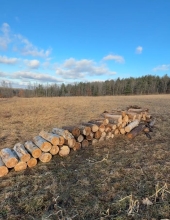



M Ljin wrote:Most wintergreen flavorings were supposedly made from black birch (another plant native to here), or are synthetic, which is mostly the case nowadays. It would be difficult to harvest enough wintergreen for commercial purposes because they are a slow-growing evergreen ground cover growing in acidic soils. The berries are quite lovely, minty and sweet tasting, something between mint and a dry blueberry perhaps?
M Ljin wrote: Partridgeberries are dryish and slightly sweet, and they have a similar ecology but prefer more alkaline or neutral soils and can tolerate more shade. They are more rambling than wintergreen as well. The berries of both persist well into winter beneath the snow and sometimes spring.
M Ljin wrote:Alder tea is nourishing-tasting. I haven’t had any in a while but have some that I brought in and dried. I specifically pick older, more lateral twigs that are gnarly because they have the better flavor. New shoots tend to be more bitter and astringent.

M Ljin wrote:Wintergreen berries and leaf tea! And partridgeberries!!!
Making a pot of alder twig tea.




